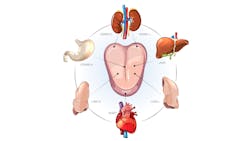Ancient tongue diagnosis for the 21st century dental hygienist
The earliest known text entirely dedicated to tongue diagnosis is Ao Shi Shang Han Jin Jing Lu (Ao’s Record of the Golden Mirror of Cold Induced Disorders). This text was published with 36 color illustrations during the Tuan Dynasty (1271–1368).1
Tongue diagnosis is a principal practice in traditional Chinese medicine (TCM), and there is increasing interest in it as research is being conducted into the validity and accuracy of this diagnostic technique.2 TCM is well accepted in the mainstream of medical care throughout East Asia, but it is still considered an alternative medical system in much of the Western world.3
As holistic health professionals, we take a view that encompasses the whole health of our patients. Learning about the ancient art and science of tongue examination and diagnosis from TCM can expand our knowledge and ability to help patients achieve optimal oral and systemic health.
You may also be interested in ... Ancient remedies: Some healing secrets for dental pain have withstood the test of time
What is traditional Chinese medicine?
TCM postulates that health is determined by a balanced flow of three substances: qi (circulating life force), xue (blood), and jin-ye (body fluids). The practitioner determines illness through imbalances in these four paired components: hot and cold, excess and deficiency, interior and exterior, and yin (passive energy and cold) and yang (active energy and heat).4
In addition, TCM is based on five organ networks: the heart/small intestine, lungs/colon, kidneys/bladder, spleen/stomach, and liver/gallbladder. When the organ networks are imbalanced, symptoms are manifested.5
Tongue analysis requires visual inspection of the tongue (vitality, color, shape, moisture, and movement) and assessment of the tongue coating (color, thickness, distribution, and root characteristics).6 The tongue is thought to provide a map of the organ systems. Characteristics of the tongue in each region provide information critical to a deeper understanding of overall health. Here is an introduction to some of the significant characteristics of Chinese tongue diagnosis.3
Tongue spirit or vitality
The tongue spirit or vitality reflects the condition of the energy, moisture, and blood. The spirits reflect the health of the heart, kidney, spleen, liver, and lungs. A thriving spirit has a soft, flexible, and moist tongue. A dry, stiff, emaciated tongue points to a withered spirit. A quivering tongue relates to digestive problems or imbalances of the liver.7
More about the tongue ... The tongue: A window to other organs
Tongue body color
In Chinese medicine, the tongue body color reflects the state of vital energy, called qi. It is an indication of the overall state of blood, circulation, and organ health. A healthy tongue is dark pink to light red. A purple tongue may signify poor circulation or chronic pain. A pale tongue reflects an imbalance in the blood or cold, as seen in eczema, anemia, excess stress, or chronic fatigue. A bright red tongue indicates the presence of heat either in excess or deficiency. It may be due to a hyperactive thyroid, high blood pressure, menopause, or allergies to food or drugs. A yellow tongue reflects bacterial overgrowth, jaundice, or stomach dysfunction. An orange tongue may be due to poor hygiene, dehydration, or excess beta carotene. White tongues are familiar to dental professionals and typically indicate fungal infections, leukoplakia, or lichen planus. A black tongue reflects keratin buildup, poor hygiene, tobacco use, radiation therapy, medication (e.g., antibiotics), and beverage stains (coffee, tea, wine).8
Tongue shape
The tongue shape relates to the blood (xue), energy (qi), and fluid (jin-ye). Curled sides suggest a stagnant liver. An enlarged tongue indicates heat in the heart, kidney, stomach, or spleen and may signal excessive alcohol consumption. Swelling indicates fluid metabolism imbalance, which can affect emotions. Partial or localized swelling reflects blood stagnation and a problem with an organ associated with the area of swelling. Swelling of the lateral borders signifies a problem with the liver or gallbladder, while swelling in the tip points to a heart problem. A scalloped tongue indicates an acute lack of energy from the spleen, food sensitivities, microbial dysbiosis, poor digestion, micronutrient deficiencies, and intestinal permeability. It may also signal high cholesterol, metabolic disorders, chronic fatigue, fibromyalgia, hypothyroidism, gluten-induced inflammatory arthritis, Down syndrome, and, as airway-centric practitioners know, a scalloped tongue can indicate sleep-disordered breathing. A short tongue may indicate excess phlegm, and a long tongue may point to dehydration. A thin tongue reflects inadequate nutrition, dehydration, or low energy. A stiff tongue signals general excess, gas, and bloating. A flaccid tongue reflects weakness. A fissured tongue may point to digestive issues, problems with the spleen, nutritional deficiencies, or heart pathology.9
Tongue coating
The coating of the tongue reflects the strength of the digestive system and pathogens affecting the body. A thin, white coating is normal. A thick, white coating can mean retention of fluids or a buildup of pathogens such as yeast/candida. A lack of coating may point to a lack of fluids and relates to menopause. A yellow coating indicates a buildup of heat in the body or a specific organ such as the stomach or intestines. It may also signal dehydration, diabetes, high cholesterol, high blood pressure, liver problems, or gallbladder disease. A gray or black coating points to extreme dysbiosis in the oral microbiome, poor hygiene, diabetes, and the effects of antibiotics or chemotherapy. An uneven coat indicates dehydration, stomach and liver disorders, gastric ulcers, interrupted sleep, and vivid dreams. A thick, greasy coat reflects excessive dehydration, inflammation, poor diet, defective digestive enzymes, lack of energy, bloating, weight gain, stiff joints, and sluggish bowels.10
Tongue moisture
A normal tongue is slightly moist. A dry tongue signals dehydration, diarrhea, uremia, acute intestinal obstruction, heat exhaustion, constipation, heartburn, gastric ulcer, hyperactive thyroid, high blood pressure, depression, anxiety, or insomnia. An excessively wet tongue points to dysfunction of the spleen.11
Tongue diagnosis as an assessment tool
Although tongue diagnosis has been used in traditional Chinese medicine for thousands of years, its validity as a medical assessment tool hasn’t been thoroughly explored in scientific studies. Preliminary research suggests that tongue diagnosis shows promise as a means of evaluating certain measures of health in patients with conditions such as rheumatoid arthritis,12 breast cancer,13 and HIV.6
Whole-health dental professionals and their patients can benefit from knowledge and understanding of tongue diagnosis. To be able to fully interpret all the varied and detailed characteristics that can be identified on the tongue, a much deeper study is required and recommended.
Editor's note: This article appeared in the November/December 2023 print edition of RDH magazine. Dental hygienists in North America are eligible for a complimentary print subscription. Sign up here.
References
- Maciocia G. Tongue Diagnosis in Chinese Medicine. Eastland Press; 1987.
- Kim M, Cobbin D, Zaslawski C. Traditional Chinese medicine tongue inspection: an examination of the inter- and intrapractitioner reliability for specific tongue characteristics. J Altern Complement Med. 2008;14(5):527-536. doi:10.1089/acm.2007.0079
- Tabish SA. Complementary and alternative healthcare: is it evidence-based? Int J Health Sci (Qassim). 2008;2(1):V-IX.
- Chaudhury RR, Rafei UM, eds. Traditional medicine in Asia. World Health Organization. 2001. https://apps.who.int/iris/bitstream/handle/10665/206025/B0104.pdf
- Matos LC, Machado JP, Monteiro FJ, Greten HJ. Understanding traditional Chinese medicine therapeutics: an overview of the basics and clinical applications. Healthcare (Basel). 2021;9(3):257. doi:10.3390/healthcare9030257
- Anastasi JK, Chang M, Quinn J, Capili B. Tongue inspection in TCM: observations in a study sample of patients living with HIV. Med Acupunct. 2014;26(1):15-22. doi:10.1089/acu.2013.1011
- Shang B, Zhang H, Lu Y, et al. Insights from the perspective of traditional Chinese medicine to elucidate association of lily disease and yin deficiency and internal heat of depression. Evid Based Complement Alternat Med. 2020;2020:8899079. doi:10.1155/2020/8899079
- Odell J. TCM tongue diagnosis. Bioregulatory Medicine Institute. 2017-2023. https://www.brmi.online/tongue-diagnosis.
- Fitzgerald K. Introduction to tongue nutrient diagnosis in functional medicine. Kara Fitzgerald, ND. 2023. https://www.drkarafitzgerald.com/2015/09/11/introduction-to-tongue-nutrient-diagnosis-in-functional-medicine-2/
- Dan M. 4 things your tongue can tell you about your health, according to TCM. Mindbodygreen. August 6, 2020. https://www.mindbodygreen.com/articles/how-to-read-your-tongue
- Rosen R. The four examinations, part 2 (tongue diagnosis in Chinese medicine). Center for Acupuncture and Herbal Medicine. July 30, 2007. https://acupunctureandherbalmedicine.com/the-four-examinations-part-2-tongue-diagnosis-in-chinese-medicine/
- Lo LC, Chen CY, Chiang JY, Cheng TL, Lin HJ, Chang HH. Tongue diagnosis of traditional Chinese medicine for rheumatoid arthritis. Afr J Tradit Complement Altern Med. 2013;10(5):360-369. doi:10.4314/ajtcam.v10i5.24
- Lo LC, Cheng TL, Chiang JY, Damdinsuren N. Breast cancer index: a perspective on tongue diagnosis in traditional Chinese medicine. J Tradit Complement Med. 2013;3(3):194-203. doi:10.4103/2225-4110.114901
Kathryn Gilliam, BA, RDH, MAAOSH, HIAOMT, educates, empowers, and inspires dental professionals to elevate their identities as oral wellness practitioners who powerfully impact the lives and health of their patients with optimal care. A published writer, consultant, international speaker, and practicing oral wellness hygienist, she founded two coaching companies, PerioLinks and Empowered Hygiene, before joining the Inspired Hygiene team as a lead productivity coach. Connect with Kathryn by emailing [email protected].
About the Author

Kathryn Gilliam, BA, RDH, MAAOSH, HIAOMT
Kathryn is an Integrative Dental Hygienist focused on optimizing whole health. She is the Founder of PerioLinks LLC, and is proud to be a Lead Clinical Coach for Inspired Hygiene. Kathryn’s interest in the medical side of dentistry led her to years of advanced study of oral-systemic connections. Nifty Thrifty’s Best Hygiene Educator of 2024, Kathryn is passionate about dental hygiene and feels her purpose is to love her patients back to health. Reach her at [email protected].
